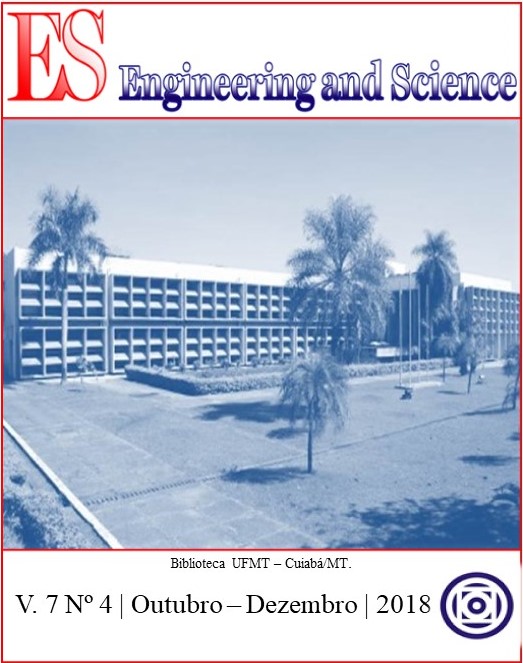Análise Fatorial Exploratória: resumo teórico, aplicação e interpretação
DOI:
10.18607/ES201877599Palavras-chave:
Análise multivariada, análise fatorial exploratória, rotação Varimax.Resumo
A análise multivariada de uma forma geral refere-se aos métodos estatísticos que analisam simultaneamente múltiplas medidas em cada indivíduo ou objeto sob investigação. Nesse contexto, entre as técnicas de multivariadas, a análise fatorial exploratória (AFE) é umas das técnicas estatísticas mais utilizadas na análise de dados em diversas áreas do conhecimento, como agronomia, zootecnia, ecologia, floresta, medicina, entre outras. AFE é uma técnica dentro da análise fatorial cujo objetivo abrangente é identificar as relações subjacentes entre as variáveis medidas. Assim, o objetivo principal deste trabalho é apresentar os principais aspectos desta técnica, como resumo teórico, apresentando uma aplicação sobre os dados de crimes do Estado de Mato Grosso e nas interpretações dos resultados obtidos por diferentes métodos da AFE. Com este trabalho pretende auxiliar pesquisadores das diversas áreas a utilizarem AFE com maior discernimento teórico e metodológico.
##plugins.generic.paperbuzz.metrics##
Referências
BARLETT, M. S. Tests of significance in factor analysis. British Journal of Psychology, v.3, p.77-85, 1950.
CATTELL, R. B. The scree test for the number of factors. Multivariate Behavioral Research,v.1, n.1, p.245-276, 1966.
COSTELLO, A. B.; OSBORNE, J. W. Best practices in exploratory factor analysis: Fourre commendations for getting the most from your analysis. Practical Assessment, Research & Evaluation, v. 10, n.7, p.1-9, 2005.
CRAWFORD, A. V.; GREEN, S. B.; LEVY, R., LO, W.; SCOTT, L.; SVETINA, D. E COLS. Evaluation of parallel analysis methods for determining the number of factors. Educational and Psychological Measurement, v.70, n.6, p.885-901. 2010.
CRONBACH, L. J. Coefficient alpha and the internal structure of tests. Psychometrika, v.16, p.297-334, 1951.
DAMÁSIO, B. F. Uso da análise fatorial exploratória em psicologia. Avaliação Psicológica, v.11, n.2, p. 213-228, 2012.
DZIUBAN, C.D.SHIRKEY, E,S. When is a correlation matrix appropriate for factor analysis? Some decision rules, Psychol, Bull, v.81, p.358-361, 1974.
FIELD, A. Discovering Statistics Using SPSS. Ed. 2, London: Sage. 2005.
FIGUEIREDOFILHO, D. B.; SILVA JÚNIOR, J. A. Visão além do alcance: uma introdução à análise fatorial. OPINIÃO PÚBLICA, v.16, n.1, p. 160-185, 2010.
GUTTMAN, L. Some necessary conditions for common factor analysis, Psychometrika, v.19, p.149-162, 1954.
HAIR JR., J. F.; WILLIAM, B.; BABIN, B.; ANDERSON, R. E. Análise multivariada de dados. 6.ed. Porto Alegre: Bookman, 2009.
HARMAN, H.H. Modern Factor Analysis. 2ª Edição. Chicago: University of Chicago Press, 1967.
HORN, J. L.A rationale and technique for estimating the number of factors in factor analysis. Psychometrika, v.30, n.1, p.179-185. 1965.
HUTCHESON, G. D.; SOFRONIOU, N. The multivariate social scientist: Introductory statistics using generalized linear models. London: Sage Publications. 1999.
JOHNSON, R.A.; WICHERN, D.W. Applied multivariate statistical analysis. 6ª Edição. Madison: Prentice Hall International. 2008. 816p.
KAISER, H.F. The varimax criterion for analytic rotation in factor analysis. Psychometrika, v.23, p.187-200. 1958.
KAISER, H. F. The application of electronic computers to factor analysis. Educational and Psychological Measurement, v.20, p.141-151, 1960.
KIM, J.; MUELLER, C. W. Factor analysis: Statistical methods and practical issues. Beverly Hills, CA: Sage Publications. 1978.
KIRCH, J. L.; HONGYU, K.; SILVA, F. L.; DIAS, C. T. S. Análise Fatorial para Avaliação dos Questionários de Satisfação do Curso de Estatística de uma Instituição Federal. E&S Engineering and Science, v.6, n.1, 2017.
LAROS, J. A. O uso da análise fatorial: algumas diretrizes para pesquisadores. Em: L. Pasquali (Org.), Análise fatorial para pesquisadores. Petrópolis: Vozes. 2004.
LORENZO-SEVA, U.; TIMMERMAN, M. E.; KIERS, H.A.The hull method for selecting the number of common factors. Multivariate Behavioral Research, v.46, n.2, p.340-364, 2011.
NEISSE, A. C.; HONGYU, K. Aplicação de componentes principais e análise fatorial a dados criminais de 26 estados dos EUA. E&S Engineering and Science, v.6, n.2, 2016.
PALLANT, J. SPSS Survival Manual. Open University Press, 2007.
PASQUALI, L. Análise fatorial: um manual teórico-prático. Brasília: EditoraUnB, 1999.
PATIL, V. H.; SINGH, S. N.; MISHRA, S.; DONAVAN, D.T. Effcient theory development and factor retention criteria: Abandon the ‘eigenvalue greater than one’ criterion. Journal of Business Research, v.61, v.2, p.162-170, 2008.
PEREIRA, J, C, R. Análise de dados qualitativos: estratégias metodológicas para as
ciências da saúde, humanas e sociais. São Paulo: EDUSP. 1999.
R DEVELOPMENT CORE TEAM. R: a language and environment for statistical computing. R Foundation for Statistical Computing, Vienna, Austria, 2018. Disponível em: https://www.R-project.org/. Acessado em: 01/11/18.
SCHWAB, A. J. Data analysis and computers II. 2007. Disponível em: http://www.utexas.edu/courses/schwab/sw388r7_spring_2007/SW388R7_Syllabus_Spring_2007.pdf. Acessado em: 01/11/18.
SPEARMAN, C. General intelligence, objectively determined and measured. American Journal of Psychology, v.15, p.201-293, 1904.
TABACHNICK, B.; FIDELL, L. Using multivariate analysis. Needham Heights: Allyn & Bacon, 2007.
VELICER, W. F. Determining the number of components from the matrix of partial correlations. Psychometrika, v.41, n.3, p.321-327, 1976.
Downloads
Publicado
Como Citar
Edição
Seção
Licença
Todos os direitos autorais devem ser cedidos a Universidade Federal de Mato Grosso.
























